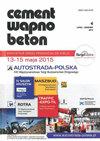水泥工业中废物和工业副产品的利用及减少二氧化碳排放的可能性-工业试验
IF 0.6
4区 工程技术
Q4 CONSTRUCTION & BUILDING TECHNOLOGY
引用次数: 4
摘要
本文旨在展示复合水泥生产中利用大量工业副产品减少CO2排放的可能性,以及波特兰熟料合成过程中减少CO2排放的可能性。最后一个将是使用含有碳酸盐以外的钙化合物的原料和使用含有生物质的替代燃料来合成熟料的结果,熟料的燃烧不包括在二氧化碳排放平衡中。用石灰石代替原混合料中1质量%的CaO,每Mg熟料可减少8 kg CO2的排放。通过工业生产试验,对CO2减排效果进行了评价和验证。熟料的原料含有碳化物、石灰或石灰石、粉煤灰。试验结果表明,在原料混合料中使用2%÷5% (Bełchatów)钙质粉煤灰,每Mg波特兰熟料可减少4.0÷10.3 kg的二氧化碳排放量。在原料混合物的组成中使用2%÷5%碳化石石灰可使每Mg波特兰熟料的二氧化碳排放量减少9.5÷23.9千克。另一方面,发展含有大量工业副产品的复合水泥生产似乎是未来几年的基本解决方案,这将大大减少水泥工业和混凝土生产中的二氧化碳排放。本文章由计算机程序翻译,如有差异,请以英文原文为准。
The use of waste and industrial by-products and possibilities of reducing CO2 emission in the cement industry – industrial trials
This article aims to present the possibility of reducing CO2 emission in the composite cement production, by using large amounts of industrial by-products and to present the possibility of reducing CO2 emission in the process of Portland clinker synthesis. The last one will be the result of using raw materials containing calcium compounds other than carbonates and the use of alternative fuels containing biomass for the synthesis of clinker, the combustion of which is not included in the CO2 emission balance. Replacing one mass % of CaO in the raw mix as limestone, reduces the emission by 8 kg CO2 per Mg of clinker. The reduction of CO2 emissions was evaluated and confirmed by industrial production trial. Clinker was produced using raw materials containing carbide lime or limestone fly ash. The results of the trial showed, that the use of 2%÷5% of Bełchatów calcareous fl y ash in the composition of the raw mix, allows of reducing the emission by 4.0÷10.3 kg of CO2 per Mg of Portland clinker. The use of 2%÷5% of carbide lime in the composition of the raw mix leads to emission reduction by 9.5÷23.9 kg of CO2 per Mg of Portland clinker. On the other hand, the development of composite cement production with a large amount of industrial by-products, seems to be the basic solution for the coming years, allowing a significant reduction of CO2 emission in the cement industry and in the concrete production.
求助全文
通过发布文献求助,成功后即可免费获取论文全文。
去求助
来源期刊

Cement Wapno Beton
CONSTRUCTION & BUILDING TECHNOLOGY-MATERIALS SCIENCE, COMPOSITES
CiteScore
1.30
自引率
28.60%
发文量
0
审稿时长
>12 weeks
期刊介绍:
The Publisher of the scientific bimonthly of international circulation, entitled "Cement-Wapno-Beton" ["Cement-Lime-Concrete"], is the Fundacja Cement, Wapno, Beton [Foundation Cement, Lime, Concrete]. The periodical is dedicated to the issues concerning mineral setting materials and concrete. It is concerned with the publication of academic and research works from the field of chemistry and technology of building setting materials and concrete
 求助内容:
求助内容: 应助结果提醒方式:
应助结果提醒方式:


